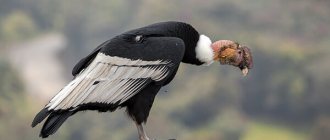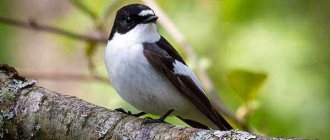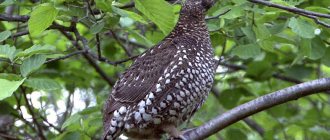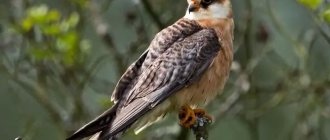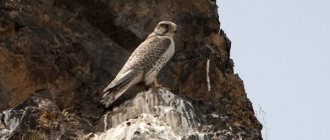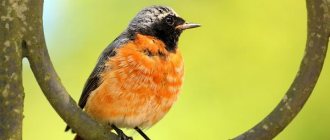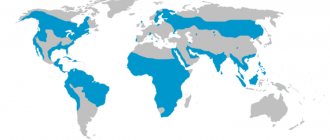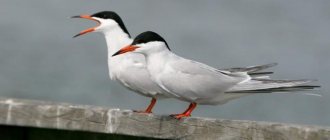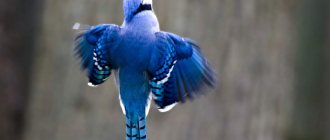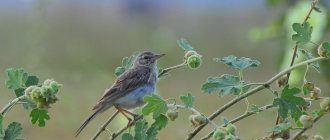| Latin name: | Vultur |
| English name: | To be confirmed |
| Kingdom: | Animals |
| Type: | Chordata |
| Class: | Birds |
| Squad: | Accipitridae |
| Family: | American vultures |
| Genus: | Condors |
| Body length: | 117—135 cm |
| Wing length: | To be confirmed |
| Wingspan: | 275—310 cm |
| Weight: | 7500—15000 g |
In addition to the Andean condor, a very rare species is known - the Californian condor, which is smaller in size. This bird almost disappeared in the 20th century, but since the 1980s, the San Diego Zoo has been implementing a program to restore this species.
- 4.1 California condor (Gymnogyps californianus)
Description of the bird
Size
— Advertising —
The Andean condor is the largest flying bird in the Western Hemisphere. The body length of adult individuals ranges from 117 to 135 cm.
Wingspan
The wingspan is 275-310 cm.
Weight
The weight of males is from 11 to 15 kg, females weigh less - from 7.5 to 11 kg. The California condor is significantly smaller in size than its relative.
Plumage and color
The condor's plumage is contrasting and expressive. Almost the entire color of the bird is black, except for the white fluffy collar around the neck and wide white edges on the wings, which are especially pronounced in males. The head and throat of the condor are not feathered, the skin in these places is pale pink or reddish-violet, sometimes brown. When a bird is excited, these areas of skin change color to yellow or red, which is a warning signal to other birds. When grooming themselves, birds themselves carefully cleanse their heads of feathers.
— Advertising —
The condor's head is slightly flattened on top. In males, it is decorated with a large, fleshy crest of a dark red color; the skin in the neck area is wrinkled and forms so-called “earrings”. The beak is long, strong, curved at the tip, black with a yellow tip. The iris of males is brown, and that of females is bright red.
The plumage of young birds is grayish-brown in color with dark, almost black, skin in the head and neck area, and a brown collar.
The paws are dark gray in color, the claws are straight and not sharp.
Claws, beak and wings
Despite the fact that the Andean condor is considered a predator, its non-sharp and straight claws do not allow them to be used as a main weapon, as well as to grab and hold prey. To do this, birds have a powerful and long beak, curved with a hook at the end and specially adapted for tearing carrion.
Due to its heavy weight and the anatomical structure of its body, the condor is not capable of active flight. He prefers high cliffs, from which he can almost immediately jump off and soar in the air. According to many hours of observations, condors are able to hold their wings in a horizontal plane for half an hour without ever flapping them. And it is very difficult for these giants to rise into the air from the ground, and they can only do this with a long running start.
The wingspan of an adult can reach 3 m, and its weight can reach 15 kg.
What does it eat?
The Andean condor feeds mainly on the carcasses of dead animals and carrion. In search of prey, the bird flies long distances, up to 200 km per day. Far from the sea, condors prefer the carcasses of large ungulates, including deer, guanacos, and cows, which die a natural death or were strangled by pumas. Near the sea coast, condors eat the carcasses of marine mammals washed ashore. In addition to carrion, condors attack other people's nests and feed on the eggs of other birds or even chicks.
The main source of food for condors is the sea coast, along which the birds inhabit a small area.
Condors find their prey thanks to their excellent vision. They also focus on the behavior of birds such as crows and American vultures. For example, the latter’s sense of smell allows them to find carcasses of animals that are in the first stages of decay, and Andean condors easily tear a carcass into small pieces, which vultures cannot do. Therefore, their two types of scavengers often feed together.
Condors can go without food for several days in a row, but then immediately eat several kilograms of meat - so much that they even lose the ability to rise into the air.
The structure of the condor's legs does not allow the bird to hold and carry prey, so they have to eat it in the same place where it was found.
The condor's diet ensures its role as an environmental health worker who, by eating animal carcasses, prevents the spread of infections.
The condor is on the verge of extinction
The Andean condor is a bird that is on the verge of extinction. The number of these majestic and powerful creatures is constantly fluctuating. Such instability is alarming, because at any moment the world could lose this beautiful lord of the mountains.
People are trying to restore the condor population, but it is very difficult to do. Chicks bred in captivity very quickly become tame, so ornithologists try to have as little contact with them as possible, so that later it will be easier for young birds to get used to the wild and to independence. Before releasing them into the wild, scientists attach sensors to their pets that show where the condor is currently located.
Where does it live?
The Andean condor lives in the Andes, mountain ranges located in western South America. The northern border of the range reaches Venezuela and Colombia, but in these places the bird is rare. In the south, the condor lives in Ecuador, Pera, Chile, Bolivia and Western Argentina to Tierra del Fuego.
In the north of their range, condors live in the upper mountain belt, at altitudes from 3000 to 5000 m above sea level; in the south they often descend to the foothills and plains.
At the beginning of the 19th century, condors were much more widespread, but recently their population has decreased markedly.
Southern royal albatross
flickr/palmchat
The southern royal albatross (lat. Diomedea epomophora) is a large bird (107-122 cm in length, weight - 8 kg). The wingspan of the royal albatross is about 280-320 cm, life expectancy is about 58 years. The long development of the bird and its low fertility is compensated by the low mortality of adults and their long life expectancy. According to statistics, every year out of 100 birds, only 3 die.
Common types
California condor (Gymnogyps californianus)
The wingspan of the California condor is up to 3 meters. Body length reaches 125 cm, weight does not exceed 14 kg. The plumage is black with white feathers on the belly; on the neck of the bird there is a black collar with sharp feathers that stick out in different directions. The beak is short and strong.
The species is very rare, found in the mountains of California, Arizona, Utah and Mexico. Previously, the California condor lived throughout the North American continent. But with its beautiful flight, the bird attracted the attention of hunters, which is why it was on the verge of extinction. In 1987, the last condor living in the wild was caught, and the total number of birds at that time reached 27 individuals. Fortunately, condors reproduce well in captivity, and already in 1992 the birds began to be released into the wild.
Tristan albatross
flickr/Projeto Albatroz
The Tristan albatross (lat. Diomedea dabbenena) is a seabird that lives in the Tristan da Cunha archipelago. Thanks to its large wingspan (350 cm), it is perfectly suited for gliding over the ocean surface. Due to their similar plumage, they were previously thought to be a subspecies of the wandering albatross. This is a very rare bird, endangered
Male and female: main differences
Sexual dimorphism in the condor is manifested primarily in the size of the bird. The weight of males is 11-15 kg, in females it is from 7.5 to 11 kg. In addition, males have a large, fleshy, dark red crest on their head, and the skin on their neck is wrinkled and forms “earrings.” On the black wings of the male condor, the white stripes along the edges also stand out more clearly.
Himalayan vulture, or snowy vulture, or kumai
flickr/Paul B Jones
The Himalayan vulture, or snowy vulture, or kumai (lat. Gyps himalayensis) is a bird of prey that lives in the highlands (from 2 thousand to 5 thousand m) of the Himalayas, Tibet, Mongolia, Tien Shan, Pamir, Sayan, etc. Range The wings of this rather large (length 116-150 cm) bird are 310 cm. Thanks to its powerful wings, the Himalayan vulture is capable of rising to a height of up to 8 thousand meters.
Reproduction
Condors reach sexual maturity between the ages of five and six years. During mating games, the skin on the head of males becomes pink or bright yellow and swells noticeably. Approaching a female, the condor stretches its neck, sticks out its chest and makes hissing sounds. Then he spreads his wings and stands in front of the female, clicking his tongue. In addition, condors perform mating dances: the male jumps, partially opening his wings, hisses and puffs. Condors are monogamous birds; once formed, a pair remains for life.
Condors nest in the upper mountain belt, at altitudes from 3000 to 5000 m above sea level. Birds make nests in hard-to-reach places, for example, on rocky cliffs, and are built from a small number of twigs, lined with a thin layer of litter. On the coast of Peru, condors often lay their eggs directly in cracks between boulders, even without bedding.
Condors lay two clutches per year. In one clutch there are 1-2 bluish-white eggs, which weigh up to 300 g and reach 100 mm in length. The incubation period for eggs is from 54 to 58 days, both partners take part in it. If an egg is lost for any reason, the female immediately lays a new one. This behavior is used by ornithologists to increase the rate of reproduction of birds using artificial incubation.
Newborn chicks are covered with thick gray down, which they retain until they reach adult size. Chicks mistake any object that catches their eye after birth for their parents.
Both parents feed the chicks; they regurgitate food from beak to beak. At the age of 6 months, the chicks begin to fly, but continue to live next to their parents for another two years.
In large groups of condors, a social structure is developed, with older birds dominating the younger ones and males dominating the females.
The lifespan of condors reaches 50 years.
Lifestyle
Condors live up to 50 years, so they can be called long-livers in the bird kingdom. A male and a female, having created a pair, remain faithful to each other throughout their lives. In large flocks of condors, older birds lead the younger ones, and in pairs, males dominate females.
These giants prefer to build their nests at an altitude of 4-5 thousand meters above sea level, in hard-to-reach places. Although this is not even a nest, but rather just a litter made of branches. Depending on the area, eggs are sometimes laid without any bedding at all, simply in crevices between boulders on the slopes.
Typically, condors occupy a small territory along the coastline; near the coast they will always be provided with food. Their keen vision helps feathered predators get food. These giants can go without food for several days, but after such a diet they eat several kilograms of meat in one lunch. Having obtained food for itself, the condor cannot transport it to its home. So the bird has only one choice - to eat to its heart’s content on the spot, and then return to its native nest with a full stomach.
When this beautiful creation of nature soars high in the sky, it is impossible to take your eyes off it, its flight is so beautiful. When a condor gains altitude, it flaps its wings very rarely. This flight is aided by the energy of the air masses, while the bird’s own energy is saved. The Andean beauty loves to relax, sitting on a rocky cornice at a high altitude. From such a perch it is easy for him to jump off and fly; it is very difficult for a heavy condor to take off from the ground, especially after a hearty lunch. To do this, the condor must take a long run and expend a lot of energy.
Interesting Facts
- A condor can remain without food for a long time, and then eat up to 3 kg of meat at once, after which it cannot take off.
- Looking for food on the ground, the condor soars in the sky for up to 3 hours, while it spends practically no energy on flapping its wings.
- Andean condors have a habit of defecating on their feet, the urine that gets on the skin evaporates and the body cools itself in this way. Therefore, the condor's paws are often covered with white streaks of uric acid.
- The Andean condor is one of the symbols of the Andes, and is also a national symbol in Argentina, Peru, Bolivia, Chile, Colombia and Ecuador. This bird is depicted on the coats of arms of Chile, Bolivia, Colombia and Ecuador. The condor plays an important role in the culture of the Andean peoples. Rock paintings of these birds appeared 2,500 BC. In the myths of Indian tribes, the Andean condor was associated with the sun deity and was recognized as the ruler of the upper world. In addition, the condor was a symbol of strength and health; the Indians believed that the bones and internal organs of the bird had healing properties. This belief led to the extermination of birds.
Amsterdam albatross
flickr/StormPetrel1
The Amsterdam albatross (lat. Diomedea amsterdamensis) is another large representative of the albatross family. This beauty is second only to the Tristan albatross by 10 cm. Its wingspan is 340 cm. It nests exclusively on the Amsterdam Islands, hence its name. The number (about 100 individuals) of the Amsterdam albatross is in critical condition, so it is classified as an endangered species.
Andean condors in captivity
One of the unexpected places where the Andean condor lives is the Moscow Zoo. As it turns out, these birds can live peacefully in captivity. Some individuals adapted so well within the walls of the zoo that they lived there for up to 70 years. The daily diet of an Andean condor in captivity is approximately 1.5 kg of meat, 200 g of fish and a couple of rats. Obviously, this menu was to the taste of exotic guests. An example of this is the condor from the Moscow Zoo named Kuzya. He was caught as an adult, but lived in captivity for more than 60 years.
Since then, many condors that came to the Moscow Zoo received the nickname Kuzya. Today, two South American birds live within the walls of the zoo - a male and a female. Let's hope that they will leave offspring, increasing the population of Andean condors on Earth. Photos of birds, majestically located in their enclosures, are kept as souvenirs in the archives of the zoo.
Lifestyle and habitat
These birds take root in places where no one can settle, since they choose mountains so high and such inaccessible rocky areas where it is almost impossible to find any living creatures nearby.
They also inhabit foothills and, in some cases, plains. But they usually prefer to settle close to the coastline, where it is easier to find food, which their naturally acute vision helps them to obtain.
These strong birds, due to the power of their huge wings, are able to soar in the sky to a height exceeding 5 km. And in search of prey, which is not often found in the mountains, they are tireless and cover up to 200 km a day.
Hurrying about their avian business and moving through the air, they reach speeds that are very significant for feathered creatures, up to 90 km/h. But once on the ground, such majestic creatures look very prosaic and even clumsy.
They become like ordinary, stupid turkeys. Here they are so awkward that they find it difficult to even rise into the air, especially if their stomach is filled to capacity. However, such birds really don’t like to be low.
The Andean condor flew out to hunt.
At moments when they are not flying, but just sitting and resting, they prefer to choose higher places: ledges of rocks or branches of majestic trees. It's all about the features of the structure. The structure of the wings of such creatures has its own individual characteristics, so during flight, to facilitate movement, they are forced to catch warm streams of air.
Hence the habit of soaring in the sky, without actively flapping its impressive wings. Condors are not loners, they form organized flocks. In them, the older generation leads the younger birds, and the females are subordinate to the males, who are even larger in size.
The male half of such birds can also be recognized by some signs: a dark red, fleshy, large crest on the head, and the skin of males wrinkles on the neck. During the nesting period, these birds make clicking, creaking and hissing sounds. This is the voice of the condor .
A great injustice to these birds on the part of man was their mass shooting in colonial America. The reason for the hatred towards such birds was the prejudice that they were supposedly capable of stealing livestock in large numbers, exterminating them, which later turned out to be a great exaggeration.
The Californian population suffered especially as a result of predatory shooting, which is very tragic. It is precisely as a result of the fact that such beauties were once shamelessly exterminated that now North American condors are practically extinct, and their numbers are extremely small.
CONDOR - A HOCKEY PLAYER CAUSED A TROUBLE AT THE MATCH. Video (00:02:28)
The championship match of the semi-professional overseas Hockey League of the East Coast was almost disrupted because of the hosts' mascot - a live condor. During the performance of the American anthem, a giant bird flew off the trainer's shoulder and decided to take a walk on the ice. He gave chase and overtook his pet at the feet of the singer, but slipped and let go of the condor. Having regained its freedom, the bird, amid the hooting of the spectators, resolutely headed to the substitutes' bench and, pushing aside the frightened Condors players who were there, suddenly attacked their head coach.
CONDOR'S NEST
The main difference between male and female condors is the size of the birds. The female is slightly smaller than the male. Female vultures, on the contrary, are larger than males.
Nest: The female usually selects a nest site on a high, inaccessible cliff and lays her egg in a simple nest. The chick is covered with thick down.
Tail: wide. The condor uses it in flight as a rudder.
— Habitat of the condor
WHERE DOES IT LIVE?
The condor is found primarily in the eastern Andes in South America to Tierra del Fuego.
PROTECTION AND PRESERVATION
This species is on the verge of extinction. Humans exterminate the animals that condors hunt (guanacos and alpacas). Sometimes condors breed in zoos.
Origin of the species and description
Photo: Andean condor
The Andean condor was introduced by Swedish naturalist Carl Linnaeus in 1758 and retains its original binomial name Vultur gryphus to this day. The general term Vultur is taken directly from the Latin vultur, meaning "vulture". Its specific epithet comes from a variant of the Greek word γρυπός (grupós, "hook nose").
Interesting fact: The exact taxonomic placement of the Andean condor and the remaining six species of New World vultures remains unclear. Although vultures on all continents are similar in appearance and have similar ecological roles, they still originated from different ancestors in different parts of the world and are not closely related. Scientists are discussing how different these two families are today.
The Andean condor is the only recognized living species of its genus, Vultur. Compared to the California condor (G. californianus), which is known from numerous fossils and some additional relatives, fossil records of the Andean condor are very sparse.
It is assumed that the early Pleistocene species of South American condors were not very different from the current species. Although one specimen extant from only a few rather small bones found in a Pliocene deposit in the department of Tarija, Bolivia, may have been a smaller subspecies, V Gryphus Patruus.
Features of behavior
The Andean condor is a powerful bird with great muscular strength. The flying predator perfectly holds its huge wings in the sky and can fly without flapping them for about 30 minutes. The feathered representative of animals carefully plans its flight, during which it uses updrafts.
In order to rise into the sky, the condor loudly flaps its wings and, trying to avoid overwork, takes flight from cliffs and rocks. The main advantage of the bird is its acute vision. This sense organ allows you to see prey at a great distance. This type of bird is distinguished by its cleanliness, so at the first opportunity it starts cleaning its feathers. During the process, condors destroy parasites, as well as particles of decomposed food. To avoid contracting fungal infections, birds defecate on their feet. The waste products contain uric acid, which kills pathogenic microflora.
Condor hunting begins early in the morning. If weather conditions are unfavorable, the bird may refrain from flying altogether. Representatives of the American vulture family lack a vocal organ.
